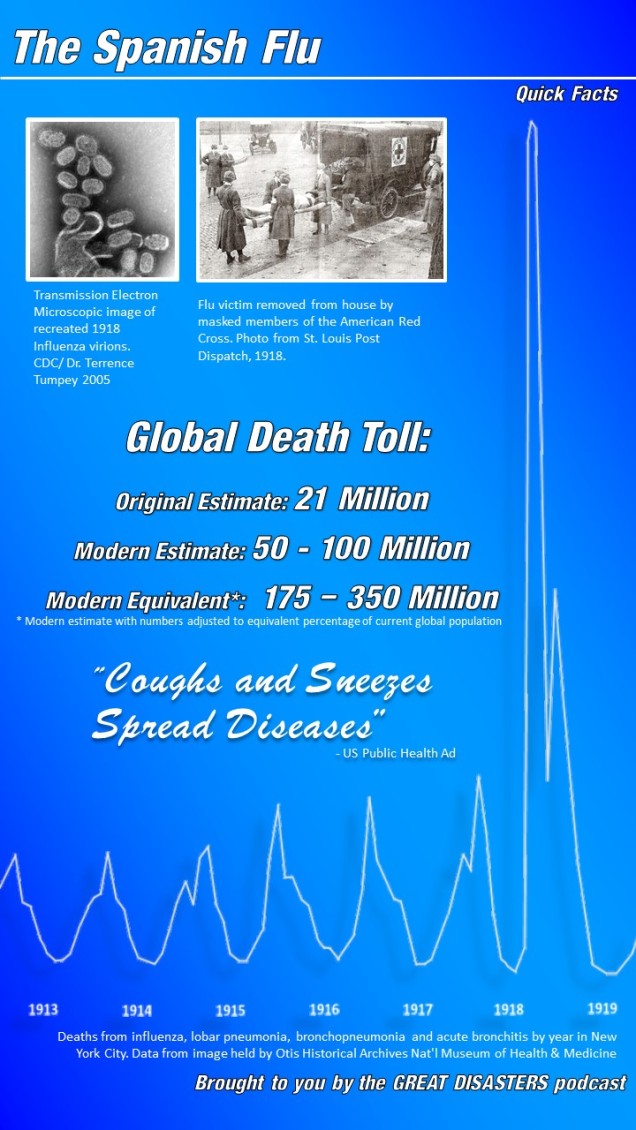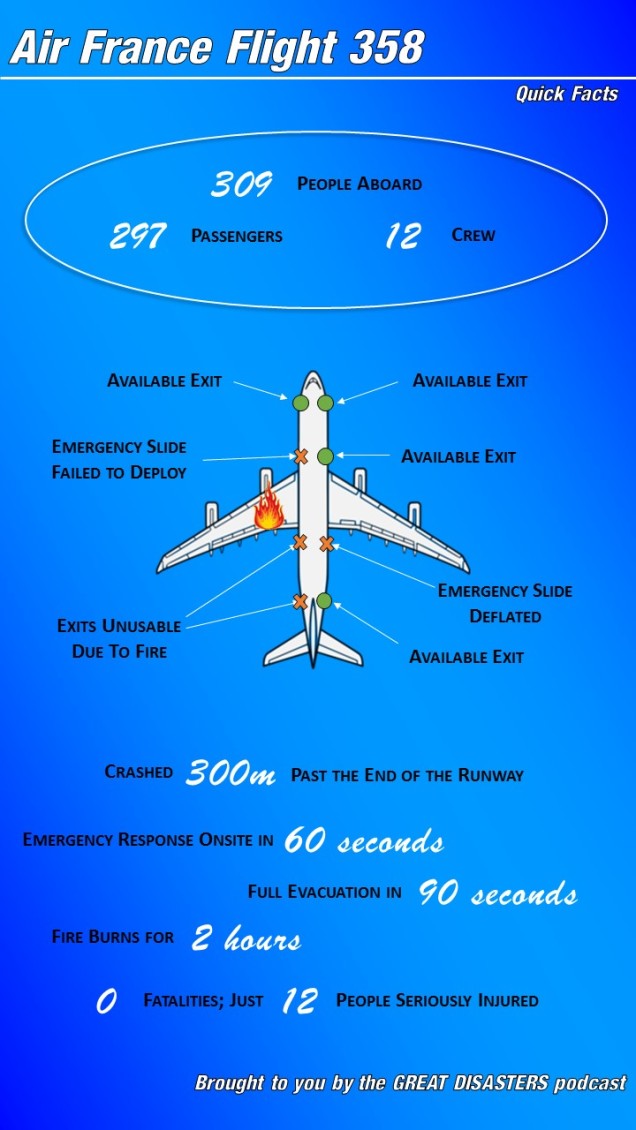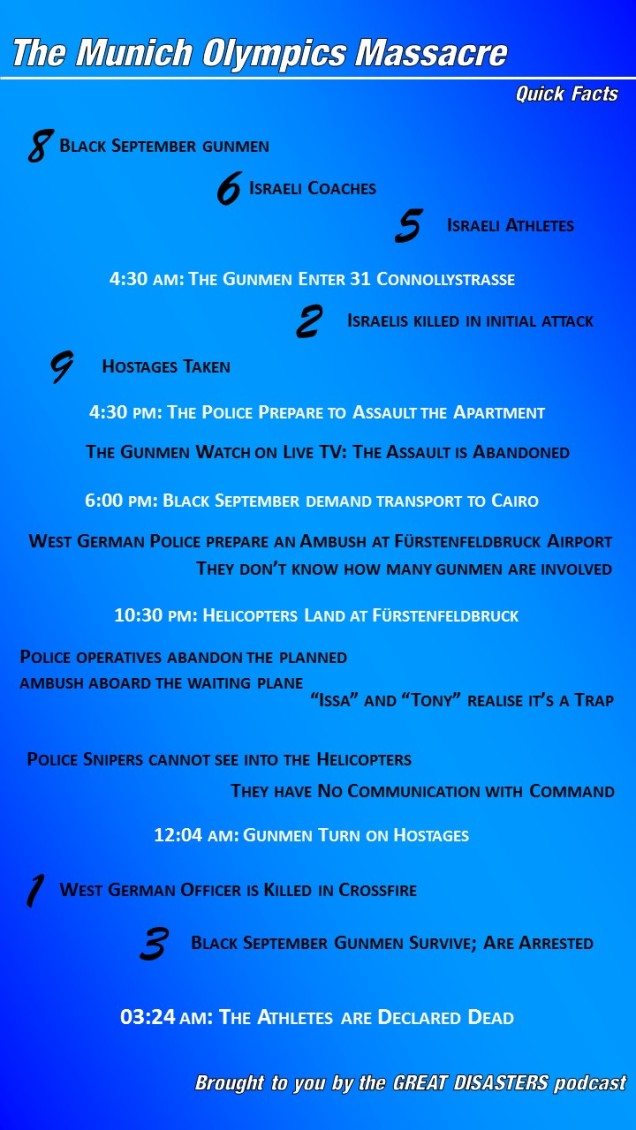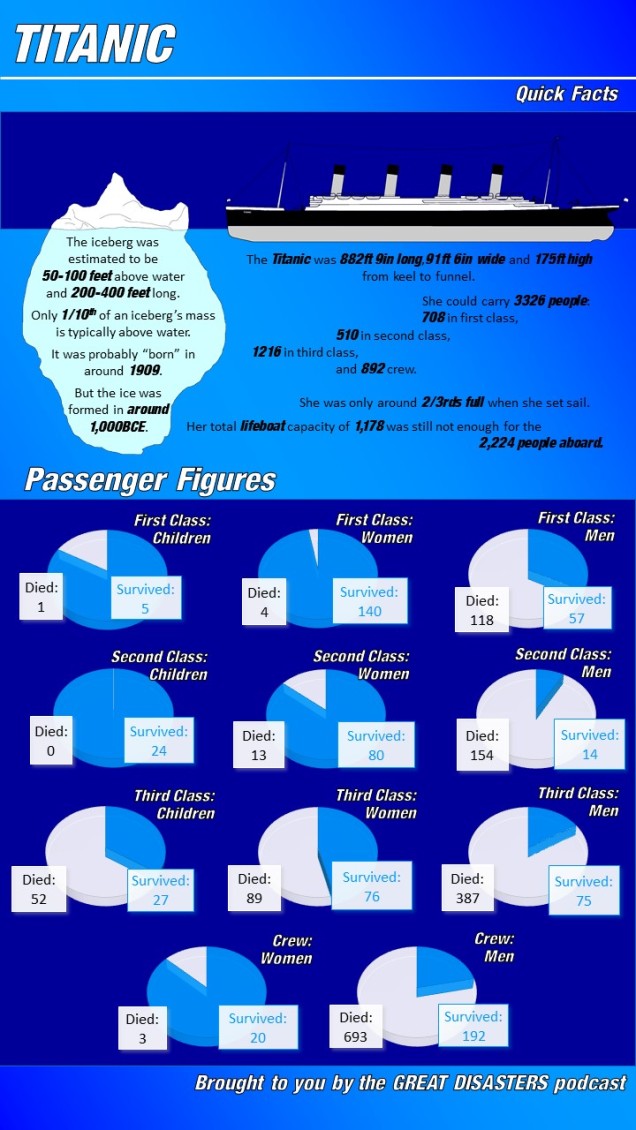This week’s scheduled episode has been postponed due to unforeseen circumstances. I apologise; hopefully we’ll be back on schedule shortly.
The Spanish Flu
Flu is something that happens to all of us (in fact, as I write this I’m battling the dreaded sniffles, sneezes and aches) so it’s hard to think of it as life-threatening. But it really is; worldwide, it’s estimated to cause 290 000 to 650 000 deaths a year.
That pales in comparison to the flu epidemic of 1918, though. That was a pandemic of unprecedented proportions, and one we thankfully haven’t seen repeated – yet. As you can see on the infographic below, the death toll soared that year, far beyond the extent of previous years’ influenza seasons, beyond even the death toll of the First World War which preceded it. (WW1 is estimated to have caused about 37 million casualties, civilian and military. Although contemporary estimates put the Spanish Flu’s death toll a little lower, at 21 million, modern estimates place it considerably higher, between 50 and 100 million.)
And the scariest thing about it? We never cured it. The most deadly pandemic in history went away by itself. Flu viruses that circulate today are, as I understand it (I’m not an epidemiologist by a long stretch), fairly closely related to the 1918 virus. The virus behind the 2009 “swine flu” outbreak is a particular example; like 1918, it was the H1N1 strain, which prompted fears of an outbreak on the scale of the Spanish Flu, and brought the pandemic of 1918 back to the public consciousness. Those fears were, thankfully, unfounded, but we would be foolish to think the danger no longer exists.
What I’m saying is, take the flu seriously; if you or anyone close to you is particularly vulnerable, consider getting the flu jab before you get the virus, and if you come down with the flu, please take good care of yourself and don’t go spreading it around.

Thanks this episode go to:
I’d like to say a special thank you to everyone who has supported me with the podcast so far; particularly to my partner Dany for putting up with me on a daily basis, and to my good friend Mew whose Christmas present will be making a big difference in episodes to come.
Thanks also go to my first Patreon supporters, spicyboi and J Fay.
Supporting the Great Disasters podcast on Patreon means you can earn exclusive rewards like seeing your name here in future!
Sources and Further Reading:
WHO Influenza (Seasonal) factsheet
Selected records from the US National Archives
Slate – The Worst Pandemic in History
The Telegraph – The war was over – but Spanish Flu would kill millions more
Time – What Made the Spanish Flu so Deadly?
The World Almanac – 1918: La Grippe
PBS- American Experience: Influenza
The Independent- Flu: how Britain coped in the 1918 epidemic
CDC – Pandemic Influenza Storybook – Joseph and Stanley Garas In Memorial
Imperial War Museums Collections
Edwardian Promenade – Living With ‘Enza: The Spanish Flu Pandemic, 1918-1919
1914-1918-online. International Encyclopedia of the First World War – Influenza Pandemic
New Zealand History – New Zealand’s First Woman Doctor
First Global Estimates of 2009 H1N1 Pandemic Mortality Released by CDC-Led Collaboration
Air France Flight 358
With the topic matter I deal with, a “festive” episode is not really on the cards. However, this incident was referred to as a miracle, so it’s probably about as close as I’ll get.
I confess that I’m not the world’s most experienced flyer; in fact I’ve only been on a plane twice in my life. That, and my interest in disasters, meant that I paid a lot of attention to what the flight attendants said. Not everybody does, though. If you’re flying regularly, you’ll get used to hearing the safety instructions. You may become a little blasé. And some people do seem to think of flight attendants as little more than airborne waiters.
The story of Air France 358 shows how much more they are. It’s thanks in large part to their training that the evacuation happened so efficiently, despite the problems that arose.
This episode also harks back to some of the things I talked about in the Prologue – the desire to stop and look, the instinct to capture a terrible moment on film. If you have a camera in your hand at the time (and let’s face it, in today’s smartphone age many of us do, at all times) you may think, “Why not?”
Media outlets have paid out a lot of money for pictures like those Eddie Ho took, but I personally doubt that this plays a large part in the act of taking the picture to start with. If your plane is on fire, or something has exploded nearby, you will be acting largely on instinct rather than thinking, “Hey, I could cash in on this!”
Rather, it’s more a reflection of our daily lives. We increasingly document our days, moment by moment, so it makes a lot of sense that it’s becoming an instinct to document disasters for ourselves, too.
It’s not always worth it, though. Better to live without that shot on your Instagram than to die trying to get it.

Sources and Further Reading/Viewing:
TSB Release – Investigation Update
Aviation Safety Network – Air France 358
USA Today – Disaster photos: Newsworthy or irresponsible?
ABC – Air France crash ‘a hell of a roller coaster’
Wikipedia article on Air France Flight 358
The crash of Air France Flight 358 was featured in an episode of Mayday/Air Crash Investigation originally aired in 2007, entitled “Desperate Escape”.
Launch Day
After something of an emotional rollercoaster, the day has arrived. I decided to launch the Great Disasters podcast today, and I am pleased to present to you the first four full episodes, covering the Titanic, the London Smog and the Munich Olympics Massacre. (You can listen to them here, or subscribe to the RSS feed.)
I honestly don’t know how many people will be reading this when it goes to press, or listening to the podcast, because some behind-the-scenes events have stopped me from doing the kind of promotion I wanted to before launch. If you are reading this, I hope that you will take the time to like the Great Disasters Podcast on Facebook, follow me on Twitter, and tell all your friends about it – I truly do appreciate your support.
From here, I am in your hands; where the Great Disasters Podcast goes in future depends very much on you, the listeners. If you have any suggestions, requests, or comments, I’ll be glad to hear from you.
I really do thank you for listening, and hope that you do stay safe.
xx
Kari Fay
The Munich Olympics Massacre
It’s hard to understand why one human being would want to kill another. It’s even harder when the two don’t even know each other; when the victim is chosen for some arbitrary reason, such as their nationality.
That’s why disasters like the Munich Olympics Massacre are so hard to confront. They are deliberate acts.
In this instance, eight men broke into the Olympic Village armed with assault rifles, pistols and grenades, and assaulted eleven unsuspecting men, who had nothing more than kitchen knives to fight back with.
Now, it is often said that one man’s terrorist is another man’s freedom fighter, and I understand that the Black September gunmen strongly felt that they had been immensely wronged, but the fact remains that they didn’t care whether the men they killed were in any way personally responsible or not. They were Israeli, and that was enough.
This event happened some time before I was even born, but I’ve seen the images again and again; the masked gunman on the balcony, the embodiment of fear.
“Terror” today seems to be something that happens every other week, at least, and it often feels like there’s nothing we can do to stop it.
That’s not true.
Co-ordinated terrorist attacks, like this one, require planning, and there are many points in the process where they can be foiled. If the authorities had paid attention to their own experts, they could have been prepared; Georg Sieber’s Situation 21 almost perfectly predicted the attack, to the last detail. If the authorities had been better prepared to respond, the rescue need not have turned into a bloodbath.
All these “ifs” do two things; they help us prepare for similar acts, and they make us grieve that we weren’t prepared to start with.
35 years later, the conflicts that triggered this atrocity remain unresolved. We can only continue to hope that love can conquer hate.
Note: I deliberately chose to omit the names of the Black September gunmen from the episode. This is not a stance on the wider Israel-Palestine debate, just my stance on their actions.

Sources and Further Reading/Viewing:
I always tend to refer to Wikipedia articles as a starting point; they may not be perfect, but they’re generally a reasonable overview and the references and bibliography should always be useful. Thus: The Munich Massacre on Wikipedia
The 1999 documentary film One Day in September is well worth watching; note that it is, in parts, graphic.
The 2005 film Munich starring Eric Bana focuses mostly on the aftermath of the attack, but it is gripping and provocative.
Some online sources include:
New York Times: Long-Hidden Details Reveal Cruelty of 1972 Munich Attackers
Telegraph: Athletics: Memories stirred of Olympic hostage horror
The Great London Smog
I chose this topic for one of the first episodes because, well, the English do love to talk about the weather, don’t we?
The thing is, that’s true because it’s usually a safe and inoffensive subject. Our changeable weather, whilst frequently miserable, doesn’t tend to hit the extremes that other countries experience. Killer weather, when it happens, is a shock.
A smog is probably not the first thing you think of when “killer weather” is mentioned. High winds, hurricanes, and blizzards might come up first. But with atmospheric pollution from industrial sources, a smog can be far more deadly than any of those.
I can’t imagine what it would be like to live with those kinds of conditions, but sadly others don’t have to imagine. Although London’s air has been cleaned up, cities like Delhi still suffer.
When you look at the figures of what was being released into London’s air in just a single day during the 1952 smog event (shown on the infographic below) it seems obvious that it would be harmful. The situation is not too different in developing cities today. The question is, have we learned the lessons of 1952 – that what we send up in smoke can, and does, come back down?

Sources and Further Reading/Viewing
Wikipedia article on the Great Smog
Met Office Case Studies: The Great Smog of 1952
How the Telegraph covered the smog of 1952
The Guardian- 60 years since the Great Smog of London – In Pictures
London’s great smog of 1952 linked to asthma surge
The Guardian – The most polluted cities in the world
Telegraph – The Great Smog of London: the air was thick with apathy
Energy UK – Electricity generation
The Crown is available on Netflix; “Act of God”, the fourth episode of the first season, is the episode referenced.
The Sinking of the Titanic
Part One:
Part Two:
The sinking of the Titanic is one of the best known, and most extensively covered, disasters of the modern age. To that end, there isn’t a great deal to be said that hasn’t been said before, but at the same time it would be a conspicuous absence if Great Disasters didn’t include it.
For me, personally, the Titanic has been something I’ve known about since I was a little girl. My mother shared my fascination with the subject, and we both watched old films like A Night to Remember and documentaries on the subject together.
I was quite small when the Titanic was rediscovered, but I do remember sharing my mother’s excitement when the first clear pictures of the wreck were broadcast.
We were never alone in our fascination with the Titanic. The tale has captured the imaginations of people across the world, from marine archaeologists and modern ship designers to writers, producers and directors in the glitzy world of Hollywood.
James Cameron’s film of the Titanic combined a romantic plotline with actual footage of the wreck; the effort involved made it the most expensive film ever made at the time, but also won the movie 11 Academy Awards. People still watch and love the film to this day – and still debate whether there was actually room on that door for two or not.
Of course, for some of us in the cinema, the plot of the film was a side show; what we really wanted to see was the ship. Cameron paid a lot of attention to detail, and it is possible to view the film as a kind of whistlestop tour of the grand liner, a tribute to her grandiose beauty.
It wasn’t just the beauty of the ship that made the tale of the Titanic so memorable; it was also the confidence with which she was imbued, the tragedy of her loss, and the sheer scale of the losses which you can see illustrated on the infographic below.

Sources and Further Reading:
I admit, I wrote a lot of this episode from memory, because I’ve been reading about the Titanic for so long I’ve got a lot of the details in my head. Very naughty of me.
Many of the first hand accounts I’ve quoted are taken from the book “Voices from the Titanic” by Geoff Tibballs.
The Wikipedia article on the sinking of the Titanic is quite comprehensive, and includes an extensive bibliography, so to save space I’m just going to point you there.
You can find a transcript of the Titanic episodes of Great Disasters here.
Until next time, stay safe.
The Fascination of Disasters
There’s something about disasters that makes us look. We know that we’re looking at something terrible, but we can’t bear to look away.
 I remember the 11th September 2001 clearly; in the office I worked in at the time, everything came to a standstill as everybody was transfixed by the news coming out of the USA. Across the country, my mother caught sight of the footage on television and sank to her knees, staying there for hours. Countless others have similar stories. It’s a universal experience.
I remember the 11th September 2001 clearly; in the office I worked in at the time, everything came to a standstill as everybody was transfixed by the news coming out of the USA. Across the country, my mother caught sight of the footage on television and sank to her knees, staying there for hours. Countless others have similar stories. It’s a universal experience.
And while disasters happen all the time – take a look at the infographic below for some quick facts – the majority of us are far more likely to be digital onlookers rather than involved first hand.
So what is it about a tragedy that fascinates us so?
That’s what I’m talking about in the special prologue episode of the Great Disasters podcast.
You can also find a transcript here.

